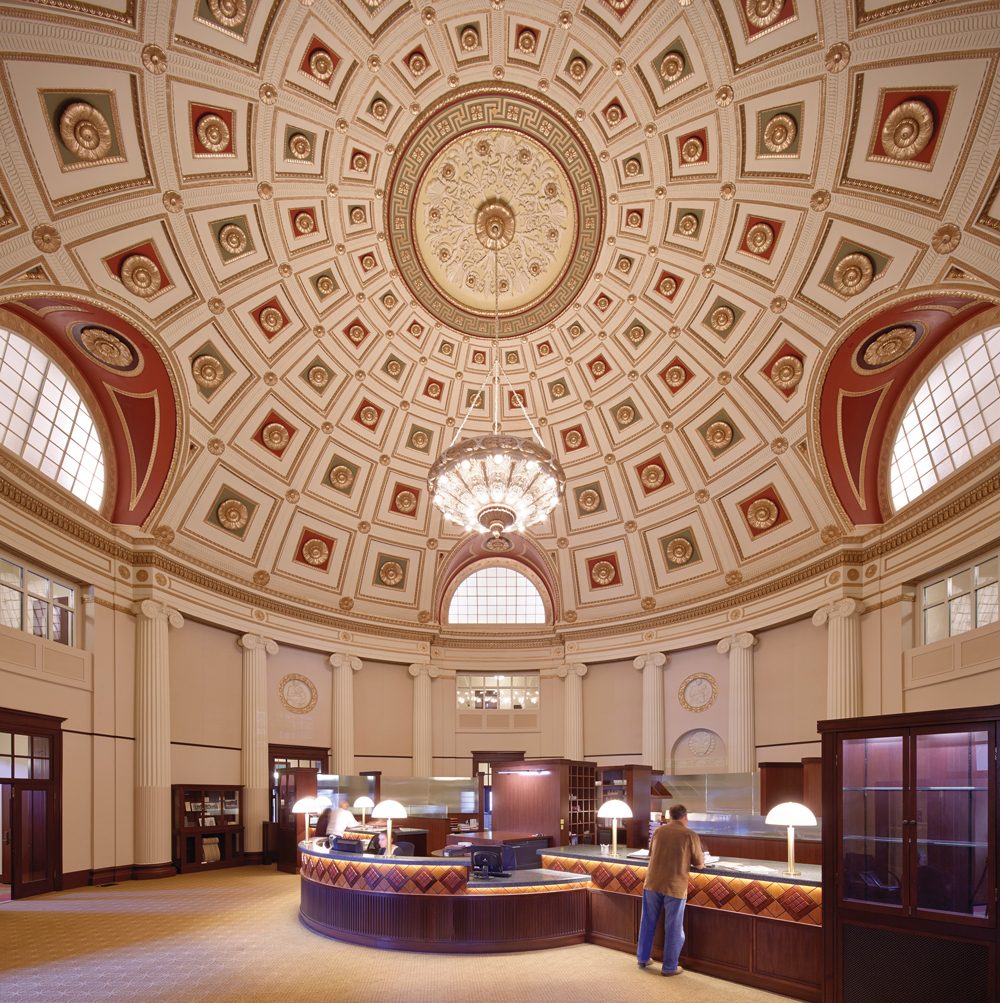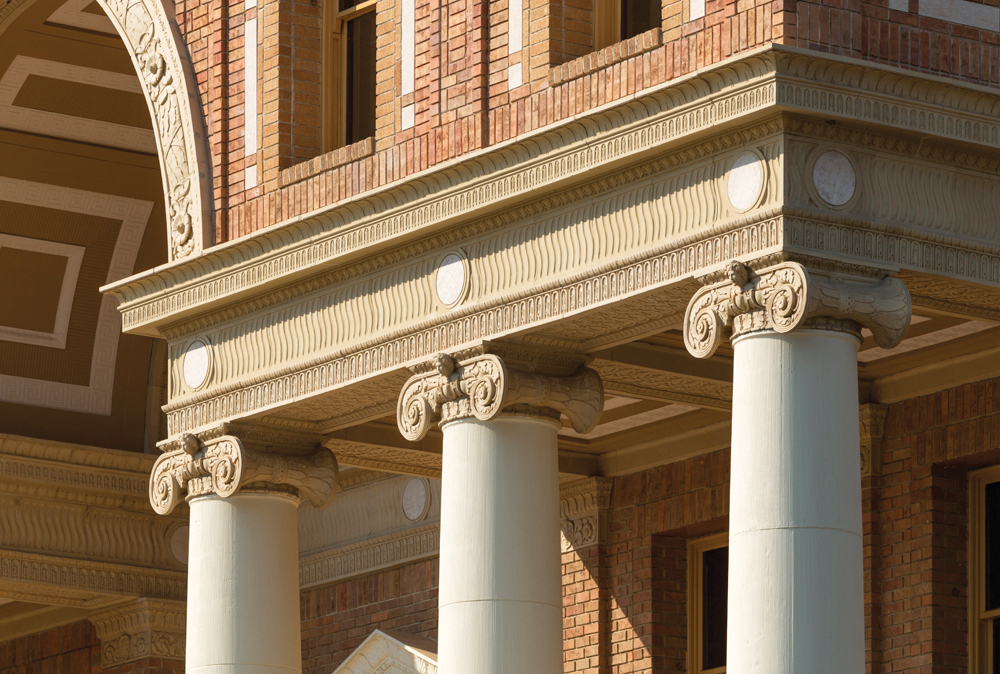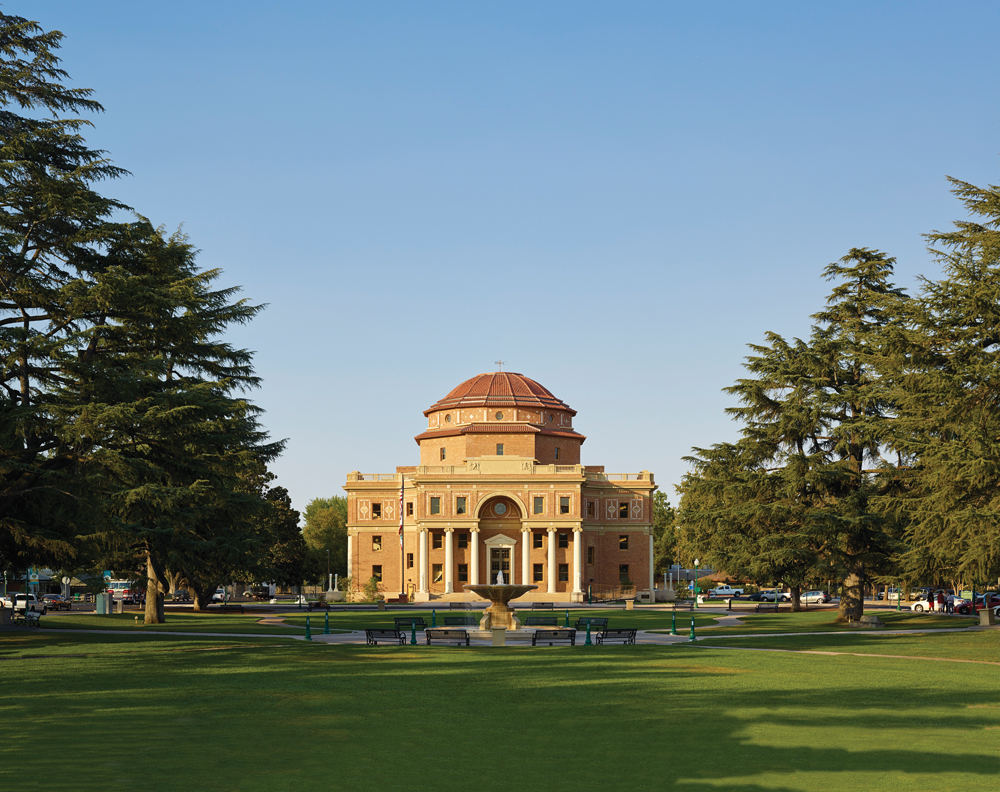Upon its completion in 1918, the building that is now the Atascadero (Calif.) City Hall was the very picture of stability. Intended as the centerpiece of Atascadero Colony—a planned utopian community—the Italian Renaissance structure featured a cruciform plan, with ornate central rotundas on the first and fourth floors.
Though the idealized colony never really jelled, the area did thrive, and the building passed through several commercial uses before the County of San Luis Obispo acquired it in 1950. When the city of Atascadero was incorporated 29 years later, the county handed the building over for city offices. The hall, with its grand pillared entrances and red-tiled dome, is featured on the city seal and listed on both the National and California Registers of Historic Places.
In December 2003, the 6.5 magnitude San Simeon earthquake ravaged Atascadero. As city workers dove for cover, the upper rotunda was twisted and wrenched away from its structural moorings. Interior walls and exterior masonry were extensively damaged, and the building was ultimately red-tagged. However, city officials were determined to restore, and improve, the beloved landmark.
Pfeiffer Partners Architects undertook a two-year assessment, including a laser-scan analysis as well as painstaking physical investigations and measurements. The Atascadero Historical Society, an enthusiastic collaborator, provided invaluable documentation of original conditions. Three packages of work were eventually developed: demolition, FEMA-funded damage repair and hazard mitigation, and city-funded rehabilitation.
PLATINUM AWARD
ATASCADERO CITY HALL
Atascadero, Calif.Building Team
Submitting firm: Bernards (construction manager)
Owner: City of Atascadero
Architect: Pfeiffer Partners Architects
Structural engineer: Nabih Youssef Associates
MEP engineer: Davidovich & Associates
General contractor: Diani Building Corp.General Information
Size: 58,900 sf
Construction cost: $21.7 million
Construction time: June 2010 to September 2013
Delivery method: CM agency/multi-prime
The 2008 economic crash posed financial difficulties, and anticipated state funding was eliminated in the subsequent recession. Meanwhile, water infiltration caused additional damage despite the owner’s best efforts to keep rain out. Under the management of Bernards, construction finally began in 2010, nearly seven years after the quake occurred.
Stabilizing the structure was obviously the most pressing need. The original building consisted of cast-in-place reinforced concrete floors and unreinforced masonry infill walls between a structural steel, concrete-encased post-and-beam skeleton. Above the fourth floor, the building was essentially an unreinforced masonry structure.
Crews strengthened the existing foundation by drilling 248 micro-piles 80 feet deep into bedrock, and pouring pile caps below the foundation. A new structural concrete slab-on-grade was installed at the basement level. Interior perimeter walls up to the fourth floor were stripped to reveal the structure, which was reinforced with more than a million tons of shotcrete and 80,000 pounds of rebar—in essence, creating a building within a building.
To fix the upper floors and dome, crews removed most of the exterior cladding, then rebuilt with additional steel and fiber-reinforced polymer instead of shotcrete, which would have been too heavy. Existing steel was horizontally and vertically braced, and roof dome framing members were retrofitted.
When structural improvements were complete, crews used as much of the original masonry as possible to rebuild the walls and roof. In the heavily damaged upper section, about 15% of the roof tiles and 80% of the bricks had to be replaced with color-matched materials. When possible, original tiles, fascia balustrades, and decorative plaster were repaired, cleaned, and returned to their original spots.

The lower rotunda benefited from a new paint scheme inspired by the greens and browns of the California landscape; the painter, a local artisan, donated half of his change-order hours back to the city. Second-floor window overlooks, once blocked, were uncovered and restored, providing views into the space from surrounding office zones. Light boxes behind frosted lunettes give the illusion of natural daylight. In reality, this dome is internal and is topped by a second rotunda housing the City Council chambers.
IMPROVING INTERIOR DESIGN
Interior reconfiguration was also crucial to improving functionality. Over the years, alterations had resulted in a confusing layout and awkwardly shaped spaces, as well as problematic ventilation. Crews removed most of the interior partitions and built new walls to establish a more sensible floor plan. Efficient HVAC and communications infrastructure was installed.
The lower rotunda was programmed as lobby space and a permit center. Three floors of offices surround this focal point. City Council chambers were constructed in the domed upper rotunda, which once held a library. A small historical museum received a place of honor, reinforcing the building’s link with the town.
More than 90% of construction dollars went to firms on the Central Coast, including $5.5 million to local glass, concrete, and masonry contractors. The final construction cost was $3.3 million less than the original $25 million estimate. Bernards credits the multi-prime contract process, encompassing 17 separately bid categories, for the savings. City Hall opened on schedule in August 2013, just in time for Atascadero’s centennial—an embodiment of civic resilience, determination, and pride.

Elegant detailing, a hallmark of the Italian Renaissance style, was re-established in the post-earthquake reconstruction.
Related Stories
Architects | Mar 8, 2024
98 architects elevated to AIA's College of Fellows in 2024
The American Institute of Architects (AIA) is elevating 96 member-architects and 2 non-member-architects to its College of Fellows, an honor awarded to architects who have made significant contributions to the profession. The fellowship program was developed to elevate architects who have achieved a standard of excellence in the profession and made a significant contribution to architecture and society on a national level.
Sports and Recreational Facilities | Mar 7, 2024
Bjarke Ingels’ design for the Oakland A’s new Las Vegas ballpark resembles ‘a spherical armadillo’
Designed by Bjarke Ingels Group (BIG) in collaboration with HNTB, the new ballpark for the Oakland Athletics Major League Baseball team will be located on the Las Vegas Strip and offer panoramic views of the city skyline. The 33,000-capacity covered, climate-controlled stadium will sit on nine acres on Las Vegas Boulevard.
Adaptive Reuse | Mar 7, 2024
3 key considerations when converting a warehouse to a laboratory
Does your warehouse facility fit the profile for a successful laboratory conversion that can demand higher rents and lower vacancy rates? Here are three important considerations to factor before proceeding.
Shopping Centers | Mar 7, 2024
How shopping centers can foster strong community connections
In today's retail landscape, shopping centers are evolving beyond mere shopping destinations to become vibrant hubs of community life. Here are three strategies from Nadel Architecture + Planning for creating strong local connections.
Market Data | Mar 6, 2024
Nonresidential construction spending slips 0.4% in January
National nonresidential construction spending decreased 0.4% in January, according to an Associated Builders and Contractors analysis of data published today by the U.S. Census Bureau. On a seasonally adjusted annualized basis, nonresidential spending totaled $1.190 trillion.
MFPRO+ Special Reports | Mar 6, 2024
Top 10 trends in senior living facilities for 2024
The 65-and-over population is growing faster than any other age group. Architects, engineers, and contractors are coming up with creative senior housing solutions to better serve this burgeoning cohort.
Architects | Mar 5, 2024
Riken Yamamoto wins 2024 Pritzker Architecture Prize
The Pritzker Architecture Prize announces Riken Yamamoto, of Yokohama, Japan, as the 2024 Laureate of the Pritzker Architecture Prize, the award that is regarded internationally as architecture’s highest honor.
Office Buildings | Mar 5, 2024
Former McDonald’s headquarters transformed into modern office building for Ace Hardware
In Oak Brook, Ill., about 15 miles west of downtown Chicago, McDonald’s former corporate headquarters has been transformed into a modern office building for its new tenant, Ace Hardware. Now for the first time, Ace Hardware can bring 1,700 employees from three facilities under one roof.
Green | Mar 5, 2024
New York City’s Green Economy Action Plan aims for building decarbonization
New York City’s recently revealed Green Economy Action Plan includes the goals of the decarbonization of buildings and developing a renewable energy system. The ambitious plan includes enabling low-carbon alternatives in the transportation sector and boosting green industries, aiming to create more than 12,000 green economy apprenticeships by 2040.
Lighting | Mar 4, 2024
Illuminating your path to energy efficiency
Design Collaborative's Kelsey Rowe, PE, CLD, shares some tools, resources, and next steps to guide you through the process of lighting design.

















